
课堂笔记
内容介绍
nginx
1 、 nginx简介
( 1 ) 什么是nginx和可以做什么事情
( 2 ) 正向代理
( 3 ) 反向代理
( 4 ) 动静分离
2 、 Nginx的安装
( 1 ) 在linux系统中安装nginx
3 、 Nginx的常用命令和配置文件
4 、 Nginx配置实例 1 反向代理
5 、 Nginx配置实例 2 负载均衡
6 、 Nginx配置实例 3 动静分离
7 、 Nginx的高可用集群
( 1 ) nginx配置主从模式
( 2 ) nginx配置双主模式
Nginx 的简介
1 、什么是nginx
Nginx是高性能的HTTP和反向代理的服务器,处理高并发能力是十分强大的,能经受高负
载的考验,有报告表明能支持高达 50,000个并发连接数。
2 、正向代理
( 1 )需要在客户端配置代理服务器进行指定网站访问

3 、反向代理
暴露的是代理服务器地址,隐藏了真实服务器IP地址。

4 、负载均衡
增加服务器的数量,然后将请求分发到各个服务器上,将原先请求集中到单个服务器上的
情况改为将请求分发到多个服务器上,将负载分发到不同的服务器,也就是我们所说的负
载均衡
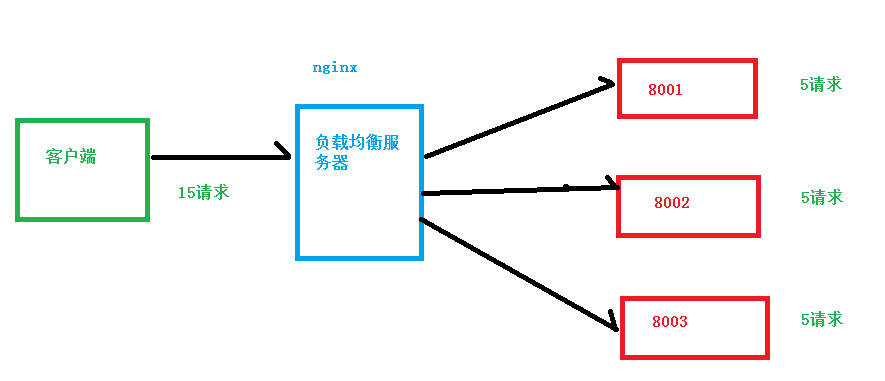
5 、动静分离
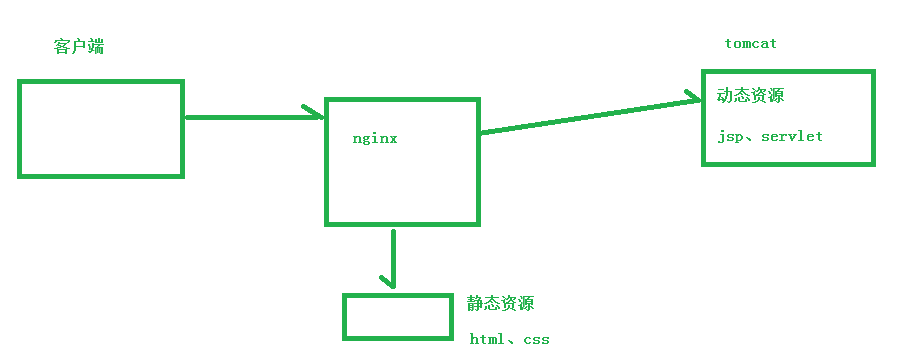
Nginx 的安装
1 、准备工作
( 1 )打开虚拟机,使用远程连接工具连接linux操作系统
( 2 )到nginx官网下载软件
http://nginx.org/

2 、开始进行nginx安装
( 1 )安装pcre依赖
第一步 联网下载pcre压缩文件依赖
wget [http://downloads.sourceforge.net/project/pcre/pcre/8.37/pcre-8.37.tar.gz](http://downloads.sourceforge.net/project/pcre/pcre/8.37/pcre-8.37.tar.gz)

第二步 解压压缩文件
使用命令
tar **–** xvf pcre-8.37.tar.gz
第三步./configure完成后,回到pcre目录下执行make,最后执行make install

( 2 )安装openssl 、zlib 、 gcc 依赖
yum -y install make zlib zlib-devel gcc-c++ libtool openssl openssl-devel
( 3 )安装nginx
- 使用命令解压
* ./configure
* make && make install
进入目录 /usr/local/nginx/sbin/nginx 启动服务
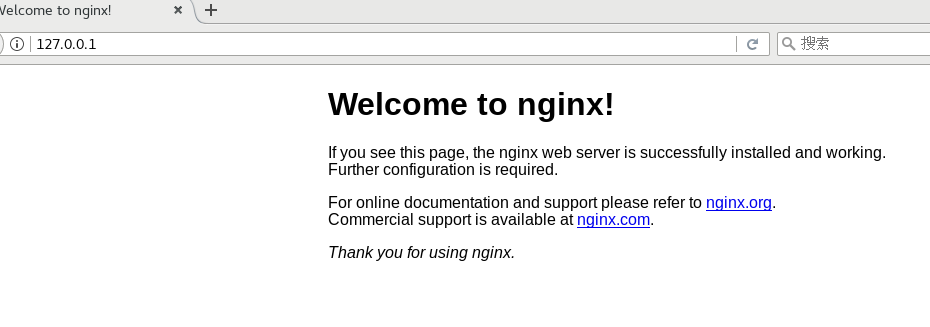
在windows系统中访问linux中nginx,默认不能访问的,因为防火墙问题
( 1 )关闭防火墙
( 2 )开放访问的端口号, 80 端口
查看开放的端口号
firewall-cmd --list-all
设置开放的端口号
firewall-cmd --add-service=http **–** permanent
firewall-cmd --add-port=80/tcp --permanent
重启防火墙
firewall-cmd **–** reload


Nginx 的常用的命令
进入nginx目录中
cd /usr/local/nginx/sbin
1 、查看nginx版本号
./nginx -v

2 、启动nginx
./nginx
3 、停止nginx
./nginx -s stop
4 、重新加载nginx
./nginx -s reload
Nginx 的配置文件
1 、nginx配置文件位置
cd /usr/local/nginx/conf/nginx.conf

2 、配置文件中的内容
包含三部分内容
( 1 )全局块:配置服务器整体运行的配置指令
比如worker_processes 1;处理并发数的配置
( 2 )events块:影响 Nginx 服务器与用户的网络连接
比如worker_connections 1024; 支持的最大连接数为 1024
( 3 )http块
还包含两部分:
http全局块
server块
Nginx 配置实例-反向代理实例 1
1 、实现效果
( 1 )打开浏览器,在浏览器地址栏输入地址 http://www.123.com ,跳转到liunx系统tomcat主页
面中
2 、准备工作
( 1 )在liunx系统安装tomcat,使用默认端口 8080
- tomcat安装文件放到liunx系统中,解压
- 进入tomcat的bin目录中,./startup.sh启动tomcat服务器
( 2 )对外开放访问的端口
firewall-cmd --add-port=80 80 /tcp --permanent
firewall-cmd **–** reload
查看已经开放的端口号
firewall-cmd --list-all
( 3 )在windows系统中通过浏览器访问tomcat服务器
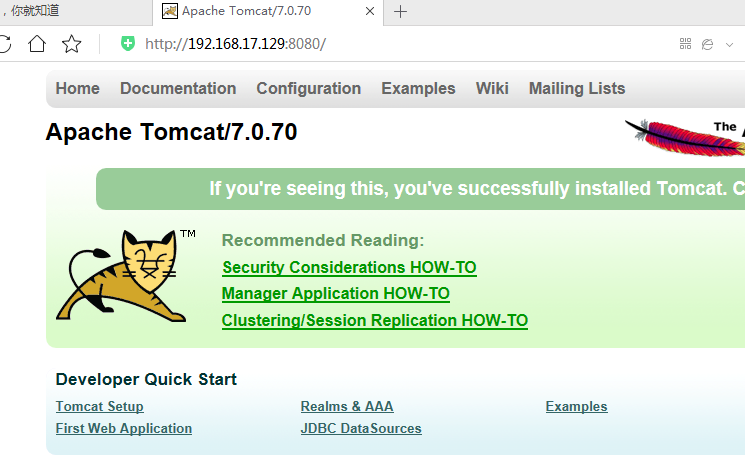
3 、访问过程的分析

4 、具体配置
第一步 在windows系统的host文件进行域名和ip对应关系的配置

( 1 )添加内容在host文件中

第二步 在nginx进行请求转发的配置(反向代理配置)
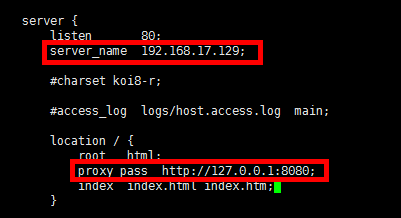
5 、最终测试

Nginx 配置实例-反向代理实例 2
1 、实现效果
使用nginx反向代理,根据访问的路径跳转到不同端口的服务中
nginx监听端口为 9001 ,
访问 http://192.168.17.129:9001/edu/ 直接跳转到127.0.0.1:808 0
访问 http:// 192.168.17.129:9001/vod/ 直接跳转到127.0.0.1:808 1
2 、准备工作
( 1 )准备两个tomcat服务器,一个 8080 端口,一个 8081 端口
( 2 )创建文件夹和测试页面
3 、具体配置
( 1 )找到nginx配置文件,进行反向代理配置
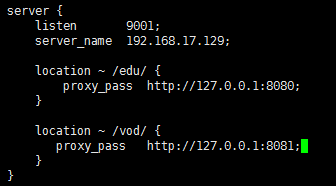
( 2 )开放对外访问的端口号 9001 8080 8081
4 、最终测试


Nginx 配置实例-负载均衡
1 、实现效果
( 1 )浏览器地址栏输入地址 http://192.168.17.129/edu/a.html,负载均衡效果,平均 8080
和 8081 端口中
2 、准备工作
( 1 )准备两台tomcat服务器,一台 8080 ,一台 8081
( 2 )在两台tomcat里面webapps目录中,创建名称是edu文件夹,在edu文件夹中创建
页面a.html,用于测试
3 、在nginx的配置文件中进行负载均衡的配置


4 、nginx分配服务器策略
第一种 轮询(默认)
每个请求按时间顺序逐一分配到不同的后端服务器,如果后端服务器down掉,能自动剔除。
第二种weight
weight代表权重默认为1,权重越高被分配的客户端越多
第三种ip_hash
每个请求按访问ip的hash结果分配,这样每个访客固定访问一个后端服务器
第四种fair(第三方)
按后端服务器的响应时间来分配请求,响应时间短的优先分配。
Nginx 配置实例-动静分离
1 、什么是动静分离
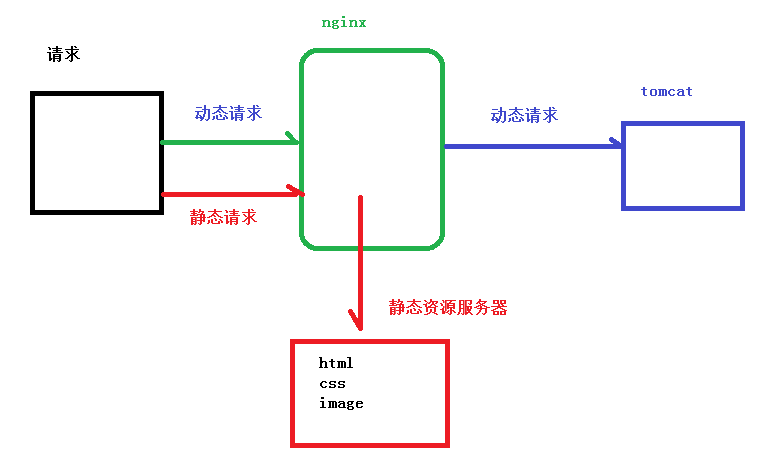
通过 location 指定不同的后缀名实现不同的请求转发。通过 expires 参数设置,可以使浏
览器缓存过期时间,减少与服务器之前的请求和流量。具体 Expires 定义:是给一个资源
设定一个过期时间,也就是说无需去服务端验证,直接通过浏览器自身确认是否过期即可,
所以不会产生额外的流量。此种方法非常适合不经常变动的资源。(如果经常更新的文件,
不建议使用 Expires 来缓存),我这里设置 3d,表示在这 3 天之内访问这个 URL,发送一
个请求,比对服务器该文件最后更新时间没有变化,则不会从服务器抓取,返回状态码 304 ,
如果有修改,则直接从服务器重新下载,返回状态码 200 。
2 、准备工作
( 1 )在liunx系统中准备静态资源,用于进行访问

3 、具体配置
( 1 )在nginx配置文件中进行配置
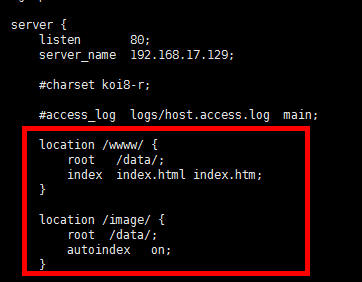
4 、最终测试
( 1 )浏览器中输入地址
http://192.168.17.129/image/01.jpg

- 因为配置文件 autoindex on

( 2 )在浏览器地址栏输入地址
http://192.168.17.129/www/a.html

Nginx 配置高可用的集群
1 、什么是nginx高可用

( 1 )需要两台nginx服务器
( 2 )需要keepalived
( 3 )需要虚拟ip
———————————————————————————
15
2 、配置高可用的准备工作
( 1 )需要两台服务器 192.168.17.129 和 192.168.17.
( 2 )在两台服务器安装nginx
( 3 )在两台服务器安装keepalived
3 、在两台服务器安装keepalived
( 1 )使用yum命令进行安装
yum install keepalived – y

( 2 )安装之后,在etc里面生成目录keepalived,有文件keepalived.conf
4 、完成高可用配置(主从配置)
( 1 )修改/etc/keepalived/keepalivec.conf配置文件
global_defs {
notification_email {
acassen@firewall.loc
failover@firewall.loc
sysadmin@firewall.loc
}
notification_email_from Alexandre.Cassen@firewall.loc
smtp_server 192.168.17.
smtp_connect_timeout 30
router_id LVS_DEVEL
}
vrrp_script chk_http_port {
script "/usr/local/src/nginx_check.sh"
interval 2 #(检测脚本执行的间隔)
weight 2
}
vrrp_instance VI_1 {
state BACKUP # 备份服务器上将 MASTER 改为 BACKUP
interface ens33 //网卡
virtual_router_id 51 # 主、备机的virtual_router_id必须相同
priority 90 # 主、备机取不同的优先级,主机值较大,备份机值较小
advert_int 1
authentication {
auth_type PASS
auth_pass 1111
}
virtual_ipaddress {
192.168.17.50 // VRRP H虚拟地址
}
}
( 2 )在/usr/local/src添加检测脚本
!/bin/bash
A=ps -C nginx –no-header |wc -l
if [ $A -eq 0 ];then
/usr/local/nginx/sbin/nginx
sleep 2
if [ ps -C nginx --no-header |wc -l -eq 0 ];then
killall keepalived
fi
fi
( 3 )把两台服务器上nginx和keepalived启动
启动nginx:./nginx
启动keepalived:systemctl start keepalived.service
5 、最终测试
( 1 )在浏览器地址栏输入 虚拟ip地址 192.168.17.50


( 2 )把主服务器(192.168.17.129)nginx和keepalived停止,再输入192.168.17.50

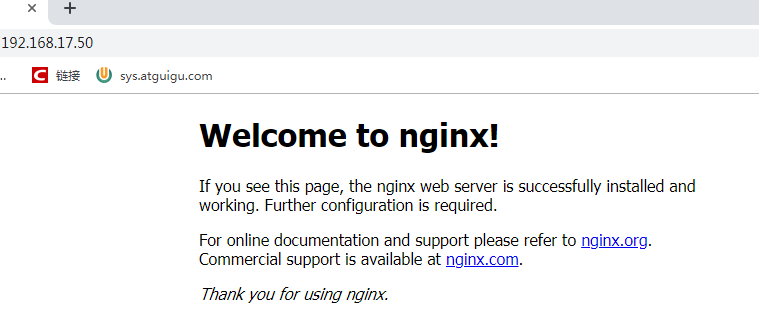
Nginx的原理
1 、mater和worker

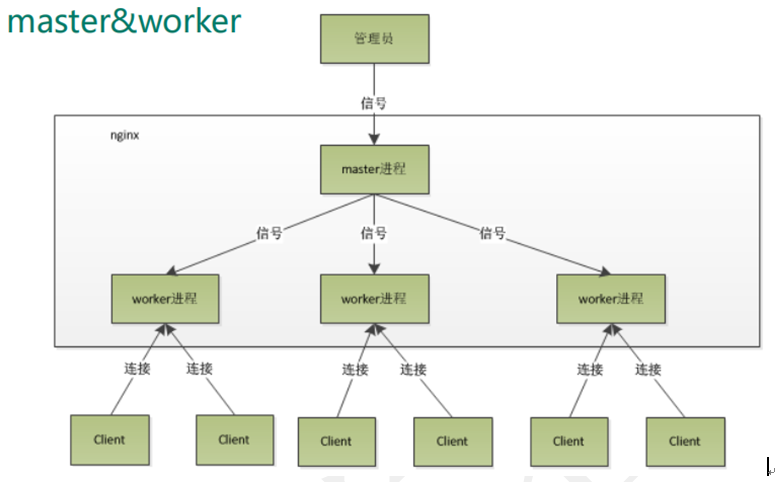
2 、worker如何进行工作的
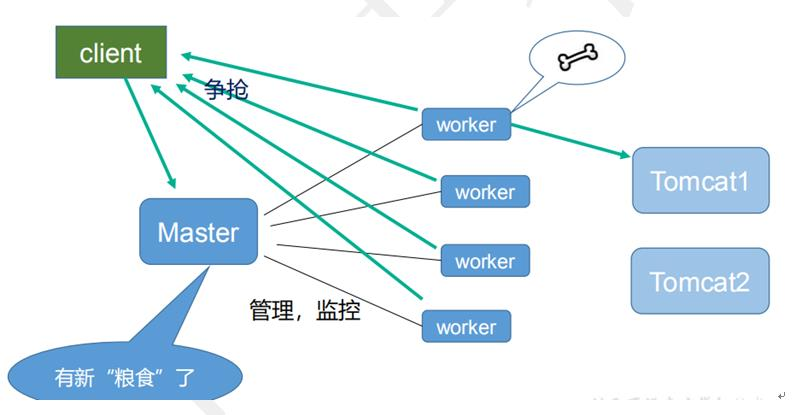
3 、一个master和多个woker有好处
( 1 )可以使用nginx – s reload 热部署,利用nginx进行热部署操作
( 2 )每个woker是独立的进程,如果有其中的一个woker出现问题,其他woker独立的,
继续进行争抢,实现请求过程,不会造成服务中断
4 、设置多少个woker合适
worker数和服务器的cpu数相等是最为适宜的
5 、连接数worker_connection
第一个:发送请求,占用了woker的几个连接数?
答案: 2 或者 4 个
第二个:nginx有一个master,有四个woker,每个woker支持最大的连接数 1024 ,支持的
最大并发数是多少?
普通的静态访问最大并发数是: worker_connections * worker_processes /2,
而如果是HTTP作 为反向代理来说,最大并发数量应该是worker_connections *
worker_processes/4。
keepalived.conf
! Configuration File for keepalived
global_defs {
notification_email {
acassen@firewall.loc
failover@firewall.loc
sysadmin@firewall.loc
}
notification_email_from Alexandre.Cassen@firewall.loc
smtp_server 192.168.200.1
smtp_connect_timeout 30
router_id LVS_DEVEL
vrrp_skip_check_adv_addr
vrrp_strict
vrrp_garp_interval 0
vrrp_gna_interval 0
}
vrrp_instance VI_1 {
state MASTER
interface eth0
virtual_router_id 51
priority 100
advert_int 1
authentication {
auth_type PASS
auth_pass 1111
}
virtual_ipaddress {
192.168.200.16
192.168.200.17
192.168.200.18
}
}
virtual_server 192.168.200.100 443 {
delay_loop 6
lb_algo rr
lb_kind NAT
persistence_timeout 50
protocol TCP
real_server 192.168.201.100 443 {
weight 1
SSL_GET {
url {
path /
digest ff20ad2481f97b1754ef3e12ecd3a9cc
}
url {
path /mrtg/
digest 9b3a0c85a887a256d6939da88aabd8cd
}
connect_timeout 3
nb_get_retry 3
delay_before_retry 3
}
}
}
virtual_server 10.10.10.2 1358 {
delay_loop 6
lb_algo rr
lb_kind NAT
persistence_timeout 50
protocol TCP
sorry_server 192.168.200.200 1358
real_server 192.168.200.2 1358 {
weight 1
HTTP_GET {
url {
path /testurl/test.jsp
digest 640205b7b0fc66c1ea91c463fac6334d
}
url {
path /testurl2/test.jsp
digest 640205b7b0fc66c1ea91c463fac6334d
}
url {
path /testurl3/test.jsp
digest 640205b7b0fc66c1ea91c463fac6334d
}
connect_timeout 3
nb_get_retry 3
delay_before_retry 3
}
}
real_server 192.168.200.3 1358 {
weight 1
HTTP_GET {
url {
path /testurl/test.jsp
digest 640205b7b0fc66c1ea91c463fac6334c
}
url {
path /testurl2/test.jsp
digest 640205b7b0fc66c1ea91c463fac6334c
}
connect_timeout 3
nb_get_retry 3
delay_before_retry 3
}
}
}
virtual_server 10.10.10.3 1358 {
delay_loop 3
lb_algo rr
lb_kind NAT
persistence_timeout 50
protocol TCP
real_server 192.168.200.4 1358 {
weight 1
HTTP_GET {
url {
path /testurl/test.jsp
digest 640205b7b0fc66c1ea91c463fac6334d
}
url {
path /testurl2/test.jsp
digest 640205b7b0fc66c1ea91c463fac6334d
}
url {
path /testurl3/test.jsp
digest 640205b7b0fc66c1ea91c463fac6334d
}
connect_timeout 3
nb_get_retry 3
delay_before_retry 3
}
}
real_server 192.168.200.5 1358 {
weight 1
HTTP_GET {
url {
path /testurl/test.jsp
digest 640205b7b0fc66c1ea91c463fac6334d
}
url {
path /testurl2/test.jsp
digest 640205b7b0fc66c1ea91c463fac6334d
}
url {
path /testurl3/test.jsp
digest 640205b7b0fc66c1ea91c463fac6334d
}
connect_timeout 3
nb_get_retry 3
delay_before_retry 3
}
}
}
nginx.conf
#user nobody;
worker_processes 1;
#error_log logs/error.log;
#error_log logs/error.log notice;
#error_log logs/error.log info;
#pid logs/nginx.pid;
events {
worker_connections 1024;
}
http {
include mime.types;
default_type application/octet-stream;
#log_format main '$remote_addr - $remote_user [$time_local] "$request" '
# '$status $body_bytes_sent "$http_referer" '
# '"$http_user_agent" "$http_x_forwarded_for"';
#access_log logs/access.log main;
sendfile on;
#tcp_nopush on;
#keepalive_timeout 0;
keepalive_timeout 65;
#gzip on;
server {
listen 80;
server_name localhost;
#charset koi8-r;
#access_log logs/host.access.log main;
location / {
root html;
index index.html index.htm;
}
#error_page 404 /404.html;
# redirect server error pages to the static page /50x.html
#
error_page 500 502 503 504 /50x.html;
location = /50x.html {
root html;
}
# proxy the PHP scripts to Apache listening on 127.0.0.1:80
#
#location ~ \.php$ {
# proxy_pass http://127.0.0.1;
#}
# pass the PHP scripts to FastCGI server listening on 127.0.0.1:9000
#
#location ~ \.php$ {
# root html;
# fastcgi_pass 127.0.0.1:9000;
# fastcgi_index index.php;
# fastcgi_param SCRIPT_FILENAME /scripts$fastcgi_script_name;
# include fastcgi_params;
#}
# deny access to .htaccess files, if Apache's document root
# concurs with nginx's one
#
#location ~ /\.ht {
# deny all;
#}
}
# another virtual host using mix of IP-, name-, and port-based configuration
#
#server {
# listen 8000;
# listen somename:8080;
# server_name somename alias another.alias;
# location / {
# root html;
# index index.html index.htm;
# }
#}
# HTTPS server
#
#server {
# listen 443 ssl;
# server_name localhost;
# ssl_certificate cert.pem;
# ssl_certificate_key cert.key;
# ssl_session_cache shared:SSL:1m;
# ssl_session_timeout 5m;
# ssl_ciphers HIGH:!aNULL:!MD5;
# ssl_prefer_server_ciphers on;
# location / {
# root html;
# index index.html index.htm;
# }
#}
}
nginx_check.sh
#!/bin/bash
A=`ps -C nginx ¨Cno-header |wc -l`
if [ $A -eq 0 ];then
/usr/local/nginx/sbin/nginx
sleep 2
if [ `ps -C nginx --no-header |wc -l` -eq 0 ];then
killall keepalived
fi
fi